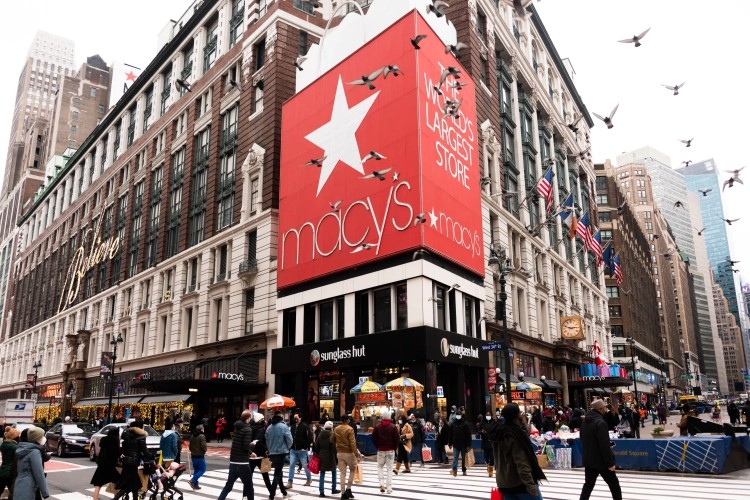美国“零售之王”再关45家门店

大约在一年之前,“零售王者”梅西百货(Macy’s)宣布了一项十分富有野心的转型计划,包括剥离旗下约四分之一的大型百货商店。
现在,梅西百货宣布了自新冠肺炎疫情爆发以来最大的一批门店关闭计划。由于疫情对业务的影响愈发明显,此举正变得越来越紧迫。梅西百货在2020年2月宣布将关闭125家门店中的45家,作为“北极星”(Polaris)计划的一部分。
大多数关闭门店早已顾客寥寥,生意惨淡,成为梅西百货的沉重负担。现在,梅西百货期望把重点放在最高水准的“A型和B型商场”(A and B malls)中的最优商店以及电商业务上。在未来几年里,梅西将专注于新型、轻型商店,目前,对该模式的测试已经在进行当中。
梅西百货的一位发言人说:“正如我们之前所宣布的,梅西公司将持续削减门店数量,将留存的零售网点集中在业绩优异、客流量大的A型和B型商场。”
数据显示,梅西百货近40%的收入来自在线业务,其还公布,在运营门店费用方面,公司前三个季度净亏损40亿美元。由此来看,闭店的举动并不令人意外。
梅西的在线业务实力提升,加上其主要竞争对手彭尼百货公司(J.C. Penney)已经于2020年破产,如此庞大的门店队伍已经不再合时宜。至于那些门客寥寥的商场,就更不必提了。事实上,由于T.J. Maxx、Ulta Beauty和塔吉特(Target)等零售商店不断侵蚀梅西的业务,这家拥有布鲁明戴尔百货(Bloomingdale’s)的零售巨头多年来一直在精简员工队伍。早在2016年时,梅西百货就关闭了100家门店。
梅西百货的首席执行官杰夫•根内特曾经计划在“北极星”项目之下重振其门店品牌,将旗下四个品牌孵化成价值10亿美元的业务,投资于剩余门店以提高吸引力。2020年11月,他向《财富》杂志透露,公司还打算推进比梅西百货规模小得多的新型门店市场,位置也会和现有商场离得很远。
与诺德斯特龙(Nordstrom)、彭尼百货、迪拉德百货(Dillard’s)等百货公司同行一样,2020年春季,梅西百货也处在不利位置——在最初的封锁期间,地方政府并没有将梅西视为“重要”零售商。
但即使在大多数零售商重新开业后,由塔吉特和Old Navy等公司占据的沿街购物中心生意恢复兴旺,室内商场却仍在遭殃。不过在疫情结束后,这一趋势仍将继续,梅西的关店计划不会就此停整。
本周早些时候,梅西百货宣布了其公司管理层一系列变动的最新动作:任命了一名新的首席商务官。在过去的13个月中,梅西百货的总裁和首席品牌体验官相继离职,财务和数字主管也进行了更换。(财富中文网)
编译:杨二一
大约在一年之前,“零售王者”梅西百货(Macy’s)宣布了一项十分富有野心的转型计划,包括剥离旗下约四分之一的大型百货商店。
现在,梅西百货宣布了自新冠肺炎疫情爆发以来最大的一批门店关闭计划。由于疫情对业务的影响愈发明显,此举正变得越来越紧迫。梅西百货在2020年2月宣布将关闭125家门店中的45家,作为“北极星”(Polaris)计划的一部分。
大多数关闭门店早已顾客寥寥,生意惨淡,成为梅西百货的沉重负担。现在,梅西百货期望把重点放在最高水准的“A型和B型商场”(A and B malls)中的最优商店以及电商业务上。在未来几年里,梅西将专注于新型、轻型商店,目前,对该模式的测试已经在进行当中。
梅西百货的一位发言人说:“正如我们之前所宣布的,梅西公司将持续削减门店数量,将留存的零售网点集中在业绩优异、客流量大的A型和B型商场。”
数据显示,梅西百货近40%的收入来自在线业务,其还公布,在运营门店费用方面,公司前三个季度净亏损40亿美元。由此来看,闭店的举动并不令人意外。
梅西的在线业务实力提升,加上其主要竞争对手彭尼百货公司(J.C. Penney)已经于2020年破产,如此庞大的门店队伍已经不再合时宜。至于那些门客寥寥的商场,就更不必提了。事实上,由于T.J. Maxx、Ulta Beauty和塔吉特(Target)等零售商店不断侵蚀梅西的业务,这家拥有布鲁明戴尔百货(Bloomingdale’s)的零售巨头多年来一直在精简员工队伍。早在2016年时,梅西百货就关闭了100家门店。
梅西百货的首席执行官杰夫•根内特曾经计划在“北极星”项目之下重振其门店品牌,将旗下四个品牌孵化成价值10亿美元的业务,投资于剩余门店以提高吸引力。2020年11月,他向《财富》杂志透露,公司还打算推进比梅西百货规模小得多的新型门店市场,位置也会和现有商场离得很远。
与诺德斯特龙(Nordstrom)、彭尼百货、迪拉德百货(Dillard’s)等百货公司同行一样,2020年春季,梅西百货也处在不利位置——在最初的封锁期间,地方政府并没有将梅西视为“重要”零售商。
但即使在大多数零售商重新开业后,由塔吉特和Old Navy等公司占据的沿街购物中心生意恢复兴旺,室内商场却仍在遭殃。不过在疫情结束后,这一趋势仍将继续,梅西的关店计划不会就此停整。
本周早些时候,梅西百货宣布了其公司管理层一系列变动的最新动作:任命了一名新的首席商务官。在过去的13个月中,梅西百货的总裁和首席品牌体验官相继离职,财务和数字主管也进行了更换。(财富中文网)
编译:杨二一
Almost a year ago, Macy’s announced an ambitious turnaround plan to modernize itself that included shedding about a quarter of its big department stores.
Now, the retailer has announced the biggest tranche since the pandemic started of those closings in a move that is gaining urgency because of the COVID-19 outbreak's impact on its business. Macy’s will soon close 45 of the 125 stores it said last February it would eventually shutter as part of its “Polaris” plan.
Most of the stores being closed are in weak malls from which shoppers have long since defected and which have become an albatross for Macy’s. The chain now wants to focus on its best stores in the highest-caliber “A and B malls,” its e-commerce business, and in the coming years, on new, smaller stores—a format it is currently testing.
“As previously announced, Macy’s Inc. is committed to rightsizing our store fleet by concentrating our existing retail locations in desirable and well-trafficked A and B malls,” a Macy’s spokeswoman said.
The move is not surprising given that nearly 40% of Macy’s revenue is now coming from its online business and given the expense of running stores in a fiscal year in which the company has reported a net loss of $4 billion during the first three quarters.
Macy’s online strength—coupled with the 2020 bankruptcy of archrival J.C. Penney—has reduced the need for such a sprawling fleet, let alone those stores located in struggling malls. Indeed, the retailer, which also owns Bloomingdale’s, has been downsizing its fleet for years as chains like T.J. Maxx, Ulta Beauty, and Target have eaten into its business. (Macy’s closed 100 stores in 2016.)
Macy’s CEO Jeff Gennette had planned under Polaris to revitalize its store brands and turn four of them into billion-dollar businesses, invest in its remaining stores to make them more appealing, and, as he told Fortune in November, forge ahead with its new, much smaller store format Market by Macy’s, whose locations will be far from malls.
Like its department store brethren, Nordstrom, J.C. Penney, and Dillard’s, Macy’s was disadvantaged last spring by not being deemed an “essential” retailer by local authorities during the initial lockdowns.
But even after most retailers reopened, business continued to boom at the strip centers occupied by the likes of Target and Old Navy, while malls struggled. With those trends certain to continue even after the pandemic ends, Macy’s won’t be missing the stores it’s closing.
Macy’s earlier this week announced a new chief merchant, the latest in a number of changes in its C-suite. In the past 13 months, the retailer has seen its president and its chief brand experience officer leave and has replaced its finance and digital chiefs.













